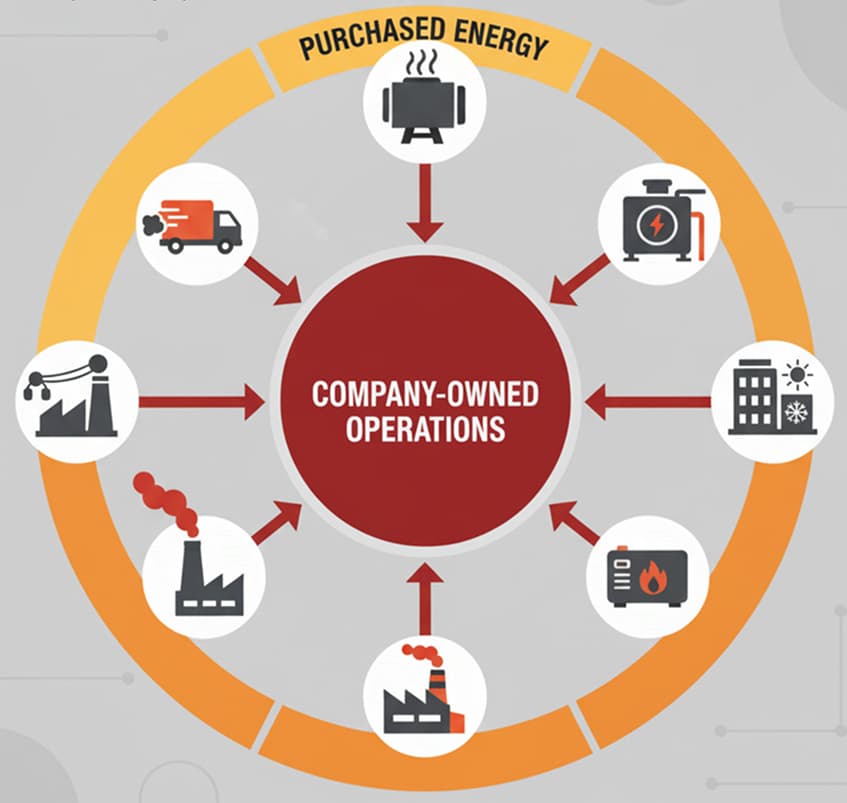Office Building Scope 2 Strategies

Transforming Commercial Real Estate Energy Performance
Office buildings account for a significant portion of commercial sector electricity consumption, with Scope 2 emissions representing the largest component of most corporate real estate carbon footprints. As organizations increasingly commit to net-zero targets, transforming office energy use becomes essential for achieving corporate climate goals.
Understanding Office Building Energy Dynamics
Office buildings exhibit predictable but complex energy patterns driven by occupancy schedules, HVAC requirements, lighting needs, and plug loads from office equipment. Unlike industrial facilities, offices typically see peak consumption during business hours with significant reductions during nights and weekends, creating opportunities for strategic energy management.
Energy Breakdown: Typical office energy use comprises HVAC systems (40-50%), lighting (20-30%), plug loads (20-25%), and auxiliary systems (5-10%). Each category offers distinct optimization opportunities.
Core Strategies for Office Scope 2 Reduction
Green Building Certifications: Pursuing LEED, ENERGY STAR, BREEAM, or WELL certifications provides frameworks for systematic efficiency improvements and renewable energy integration. Certified buildings typically use 25-30% less energy than conventional buildings.
Renewable Energy Procurement Options:
- On-site solar installations on rooftops and parking structures
- Green power purchase agreements for tenants and building owners
- Participation in community solar programs
- Renewable energy certificates for remaining grid electricity
Smart Building Technologies: Building automation systems, occupancy sensors, smart lighting controls, and IoT-enabled HVAC optimization can reduce energy consumption by 20-35% while improving occupant comfort.
Tenant Engagement Programs: Green lease structures that align landlord and tenant incentives, energy monitoring dashboards, and sustainability competitions drive behavioral change and operational improvements.
Advanced Building Optimization
Demand Response Participation: Offices can reduce peak demand charges and support grid stability by curtailing non-essential loads during peak periods. Automated demand response systems enable participation without disrupting operations.
Retrofit Strategies: LED lighting upgrades, HVAC modernization, building envelope improvements, and window film installations offer significant efficiency gains in existing buildings. Deep retrofits can achieve 40-50% energy reductions.
Electrification Initiatives: Replacing natural gas heating with heat pumps and electric systems enables greater Scope 2 control while often improving efficiency. This strategy becomes increasingly effective as grids decarbonize.
Energy Storage Integration: Battery systems can reduce demand charges, provide backup power, and enable greater renewable energy utilization, particularly when paired with on-site solar.
Overcoming Office-Specific Challenges
Split Incentive Problem: When building owners pay for upgrades but tenants receive energy savings, investment incentives misalign. Solutions include green leases, utility bill allocation, and performance-based contracts.
Multi-Tenant Complexity: Coordinating energy initiatives across multiple tenants requires clear communication, shared goals, and collaborative governance structures.
Capital Planning Cycles: Align energy projects with regular capital improvement schedules and maintenance cycles to minimize disruption and optimize costs.
Historic Building Constraints: Older buildings may have architectural restrictions or structural limitations. Focus on operational improvements and less invasive technologies.
Implementation Pathway
- Energy Audit and Benchmarking: Assess current performance using ENERGY STAR Portfolio Manager or similar tools
- Occupant Engagement: Launch awareness campaigns and gather feedback on comfort and priorities
- Quick Wins: Implement low-cost measures like LED upgrades and control adjustments
- Strategic Planning: Develop multi-year roadmap aligning with lease cycles and capital plans
- Procurement Strategy: Evaluate and implement optimal renewable energy procurement approach
- Continuous Commissioning: Regular testing and adjustment to maintain optimal performance
- Performance Tracking: Monitor and report progress to stakeholders
Workplace Evolution and Energy Implications
Hybrid work models are reshaping office energy profiles. While reduced occupancy can lower consumption, maintaining comfort for variable occupancy requires sophisticated control systems. Activity-based working and hoteling create opportunities for space optimization and corresponding energy reductions.
Future-Ready Design: New offices increasingly incorporate flexibility for changing uses, extensive daylighting, natural ventilation options, and infrastructure for on-site renewables and EV charging.
Financial Considerations
Office Scope 2 initiatives offer compelling returns through energy cost savings, increased asset values, higher rental rates, improved tenant retention, and reduced climate risk exposure. Green buildings command average rental premiums of 3-7% and sell for 10-15% more than conventional buildings.
Regulatory Landscape
Cities worldwide are implementing building performance standards, emissions limits, and disclosure requirements. New York's Local Law 97, the EU's Energy Performance of Buildings Directive, and similar regulations make Scope 2 reduction mandatory rather than optional.
Best Practices from Leading Organizations
Progressive companies are achieving net-zero offices through integrated strategies combining deep efficiency retrofits, maximum on-site renewable generation, high-quality off-site renewable procurement, and innovative financing mechanisms. Success factors include executive sponsorship, dedicated sustainability teams, and treating energy management as a core business function rather than a facilities issue.